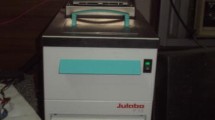Abstract
In this study, ultrasonic velocity measurements were used to estimate the alcohol type and volume concentration in water–alcohol binary mixtures. Varying mixtures of ethanol in water and methanol in water were prepared and the ultrasonic velocities for each concentration level were measured between 10 and 50 °C. Results of the statistical analyses indicated that ultrasonic velocity measurements can be used to distinguish between ethanol and methanol in a water–alcohol binary mixture and to estimate the alcohol concentration level. The results were validated by testing three commercial liquids with a known ethanol concentrations and one commercial liquid with known methanol concentration.






Similar content being viewed by others
References
Miles CA, Fursey GAJ (1977) Measurement of the fat content using ultrasonic waves. Food Chem 2:107–118
Ghaedian R, Coupland JN, Decker EA, McClements DJ (1998) Ultrasonic determination of fish composition. J Food Eng 35:323–335
Chanamai R, McClements DJ (1999) Ultrasonic determination of chicken composition. J Agric Food Chem 47:4686–4692
Benedito J, Carcel JA, Rossello C, Mulet A (2001) Composition assessment of raw meat mixtures using ultrasonics. Meat Sci 57:365–370
Resa P, Elvira L, Espinosa FM (2004) Concentration control in alcoholic fermentation processes from ultrasonic velocity measurements. Food Res Int 37:587–594
Resa P, Elvira L, Espinosa FM, Gomez-Ullate Y (2005) Ultrasonic velocity in water-ethanol-sucrose mixtures during alcoholic fermentation. Ultrasonics 43:247–252
Winder WC, Aulik DJ, Rice AC (1970) An ultrasonic method for the direct and simultaneous determination of alcohol and extract content of wines. Am J Enol Viticult 21(l):1–11
Rabinovich A, Tulimieri D (2004) Ultrasound sensing of concentration of methanol's aqueous solution. United States Patent 6748793
Povey MJW (1997) Ultrasonic techniques for fluids characterization. Academic Press. San Diego, pp 50
Arrigo GD, Paparelli A (1988) Sound propagation in water–ethanol mixtures at low temperatures. I. Ultrasonic velocity. J Chem Phys 88(1):405–415
Giacomini A (1947) Ultrasonic velocity in ethanol–water mixtures. J Acous Soc Am 19(4):701–702.
Benedito J, Mulet A, Clemente G, Garcia-Perez JV (2004) Use of ultrasonics for the composition assessment of olive mill wastewater (alpechin). Food Res Int 37(6):595–601
Author information
Authors and Affiliations
Corresponding author
Rights and permissions
About this article
Cite this article
Vatandas, M., Koc, A.B. & Koc, C. Ultrasonic velocity measurements in ethanol–water and methanol–water mixtures. Eur Food Res Technol 225, 525–532 (2007). https://doi.org/10.1007/s00217-006-0448-0
Received:
Revised:
Accepted:
Published:
Issue Date:
DOI: https://doi.org/10.1007/s00217-006-0448-0



